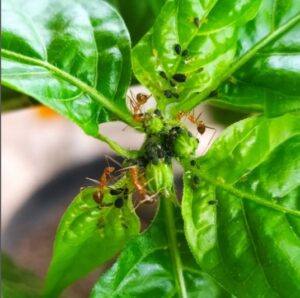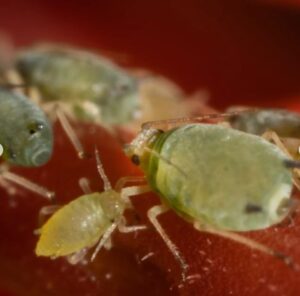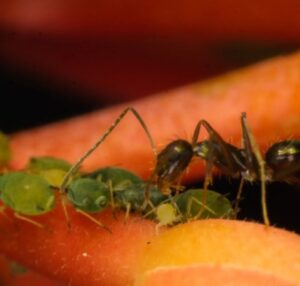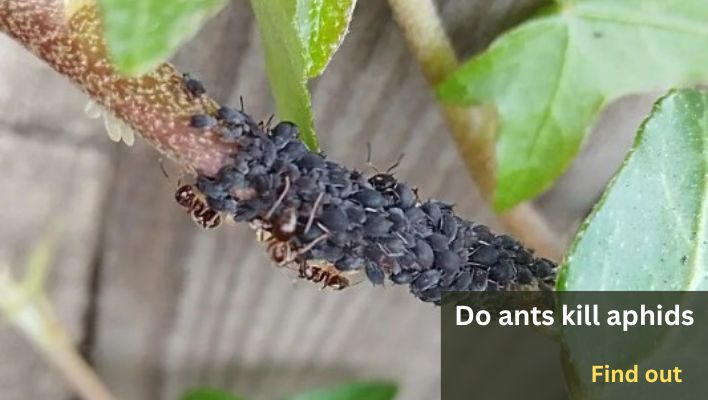Ants are a common part of homes, garden landscaping, and our ecosystem. Many gardeners have reported seeing ants in their gardens after sporting aphids on their plants. For this reason, they want to know the relationship between these insects or do ants kill and feed on aphids.
Ants are among the few creatures that are known to eat aphids. Some species will follow and keep any aphids they catch around. Even in other ant species, ants may be responsible for transmitting aphids between colonies. Ants love aphids and will do whatever they can to protect and feed on them.
Ants are usually friendly and helpful insects, but they can be a bit of a pest when they invade your garden, mostly attracted by the presence of aphids or mealybugs.
They do not intend to harm, but they’ll make a mess like any other pest, even the ant species that like to eat aphids. This analyzes everything you need to know about the relationship between aphids and ants and how to keep your garden free of them.
Ants and Aphids Symbiotic Relationship
A symbiotic relationship exists between ants and aphids. Ants and aphids are members of the order Hemiptera, but they are far from being friendly when in your garden. Ants protect aphids from predators, and aphids provide food to ants.
While ants are social insects that live in colonies of up to several million individuals, aphids are solitary insects that live alone or in small groups. Ants and aphids have a mutualistic relationship with plants. They help the plant by collecting food for themselves and their host plant.

In fact, these relationships can be extremely specific and quite strange. A whole category of ants, known as myrmecophiles (ant lovers), takes up residence inside ant colonies, and aphids provide honeydew voluntarily in return for protection, food, and other benefits.
Aphids are a type of insect that sucks plant sap and excrete honeydew. The sticky substance caused sooty mold on plants. This sticky substance attracts ants which keeps them safe from other insects, like ladybugs or lacewings. Ants don’t care if they eat the aphid, but they will attack any bugs that try to eat it.
However, ants benefit the garden; they collect nectar from flowers for their food supply and use it to feed their larvae. This is where the aphid comes in: it sucks up the nectar and stores it in its body so that it can be used later by the ant colony. This allows ants to collect more nectar than they could if they had to search for it independently. If you have aphid infestation, here is a detailed guide to getting rid of them.
Ants and the aphid lifecycle
Ants and aphids are both insects, but they have different lifecycles. Below is everything you need to know about these two insects.
Ants lifecycle
The ant is a social insect that lives in colonies with multiple generations. Ants live in nests and forage for food together, which is called “coloniality.” The aphid is an individual that lives alone and does not form colonies.
They can only reproduce through fertilization from another individual of their species. The aphid lifecycle involves three stages: egg, nymph, and adult.
Ant eggs hatch into nymphs that look similar to adults but do not yet have wings or antennae. These nymphs stay in the same area until they grow into adults, which look like small versions of queen ants.
Queen ants lay eggs during their mating season, which will hatch into new nymphs who will continue to live inside the colony until they are ready to leave on their own (known as eclosion).
While they’re still inside their cocoon they must eat their fill before they can break out; this process takes about two weeks, after which they emerge as adults, ready to go outside and start searching for food on their own.
Aphids Lifecycle
Aphids are a type of small, soft-bodied insects that can be found on plants, trees, and shrubs. They are related to the whitefly and greenfly species. The lifecycle of an aphid begins when an egg is laid. These eggs are laid in the soil or on a leaf. Find out how your plants got aphids here.
The eggs hatch into wingless larvae, which are called nymphs. Nymphs have many features in common with aphids; they have a piercing-sucking mouthpart that injects saliva when they feed on plants, but they are smaller, with shorter antennae and legs, and lack wings. Although they may grow wings when they want to move to other plants.

Aphid nymphs shed their outer casings (exoskeletons) as they grow and become adults. In this stage, the aphids feed on other plants before returning to their colony to mate and lay eggs.
After mating, female aphids produce eggs over several weeks until they reach maturity and can no longer reproduce sexually; they then die off after laying their eggs in a plant’s roots or stems during late summer through early fall. Adult females can lay as many as 500 eggs during their lifetime.
How do Ants Farm Aphids
Ants farm aphids by eating the aphids and then storing the substances in their bodies. The ants then release these substances when needed, and the aphids are consumed again. This process is called “recycling.”
The ant uses its body to store the substance that it has collected from the aphid, which can be used as food later on. The ant also stores honeydew, which aphids give out as a reward for being fed. This can be used later on, but not necessarily in the same way, other foods would be used.
Ants don’t have teeth, but they do have mouthparts that work like a drill to pierce the aphid’s body and suck out honeydew.

Ants can farm aphids in several ways.
One of the simplest ways to farm aphids is by using ant pheromones. When an ant finds a field of aphids, it will release a pheromone that attracts other ants to the area. The ants then lay eggs in the field and eventually hatch, eating the aphids.
Another way to farm aphids is by growing them in a colony environment. This type of farming requires more effort on behalf of the ants and requires them to take care of their young for several weeks before they leave the nest.
Which ants farm aphids
The most common species of ants that farm aphids are the carpenter and herder ants. These ants can be found on many plants and trees. They often nest in cracks and crevices or where they have access to nectar and pollen.
They are considered a pest because they eat sap from trees but also help keep other insects away from the tree’s bark. The leaf-cutter ants are another species that farm aphids. The ants take honeydew back to their Other species of ants that also farm aphids include
- Myrmecophiles: These ants farm aphids using their mandibles to tunnel into the aphid’s body and suck out its sap. The queens do not ingest food but may consume honeydew or nectar produced by the aphids.
- Crematogaster Trilineata: This species is one of North America’s most important foraging ants, although it does not commonly use aphid hosts. However, it has a tremendous impact on aphid populations through predation, dispersal, and parasitism.
- Formicoxenus Rosae: This species lives in tropical rainforests and produces some of the world’s largest colonies, up to 50,000 workers per colony. It also significantly impacts other arthropod species through predation and parasitism.
Why do ants protect aphids?
Ants protect aphids because they feed on them. The aphids are a delicacy for the ants, so they want to keep them safe from predators. The aphids secrete a sweet substance that attracts the ants to their colonies, protecting them from predators.
Ants are a vital part of the ecosystem and protect aphids in many ways. Ants can ward off predators by driving them away or by killing the predators before they can eat their aphid prey.

An ant guarding its aphid will also ensure that other insects won’t eat it. They do this because they need the protein in aphids to survive.
Ants also protect aphids from bacteria by licking them clean with their sticky feet. This is not only good for keeping the ants healthy; it helps keep the aphid clean as well.
Signs of Aphids in a Garden
Aphids are tiny insects that reproduce quickly. They can be a nuisance to gardeners, they cause wilting and stunt growth in plants, also their presence can cause other diseases.
They do this by sucking sap from plants and trees, causing them to become distorted. Aphids can be found on various plants, including grasses, vegetables, and ornamentals.
Some signs of aphids infestation include;
- The leaves of your plants begin to curl or curl up at the tips. This indicates that aphids have started feeding on your plant, which can cause it to die.
- The leaves of your plants are turning pale and yellow,
- The infested plant may have yellowed leaves and stunted growth.
- The presence of a sticky substance that looks like honeydew (a sugary liquid excreted by aphids)
- You can see the aphids by looking at the stems, leaves, or flowers of plants in your garden.
Aphids and ants beneficial or harmful
Aphids are a common issue in the garden and can be beneficial and harmful to your plants. Aphid infestations are often the result of an imbalance in the ecosystem. These pests are small and green and suck the sap from plants.
They are also known to spread viruses from plant to plant. Aphids secrete honeydew, which may attract sooty mold fungus, which feeds off the honeydew as it drips down onto leaves below. So if you see aphids on your plant, you should also look for yellowing leaves or wilting signs.
However, aphids aren’t always bad for your garden; they can help keep your plants healthy by feeding on bacteria that cause diseases like downy mildew and powdery mildew.
Unlike aphids, ants are beneficial to your garden. They feed on aphids, so if you see an ant colony in your yard, check first whether there are any aphids nearby. Ants are also great at keeping other bugs away from your plants, so they can help you grow a healthy crop of food.
Also, ants help clean your garden by eating away at dead insects, such as aphids and mites, which can lead to unsightly fungus growth on your plants’ leaves. It is necessary to know that ants in your garden are caused by aphids, which need to be treated.
Ants Farming Aphids and What to do About It
Ants are wonderful creatures, but they can also be pests. They are often found around the garden in search of food. Ants can be a problem when they start farming aphids.
Ant farms need to be eliminated from your garden because they will make it very difficult for you to grow plants. Getting rid of ants and aphids is important to ensure a healthy and pest-free garden. Below are the various ways to get rid of aphids and ants in your garden and prevent aphid infestation.
Apply insecticidal soap.
One of the most effective ways to get rid of aphids is by using insecticidal soap. Apply insecticidal soap in the morning or the evening when aphids are inactive.
Spray insecticidal soap directly on the leaves of the plant you’re treating, and make sure to cover all surfaces, including the undersides of the leaves. Repeat this process if you see aphids on your plants until all aphids are gone.
This method is safe for most plants, including fruit trees and vegetables. It won’t harm your garden bed or garden plants like insecticides can do if you use them incorrectly or too often. You can also apply an insecticidal soap solution directly to the base of infested plants.
Spray with Neem oil.
Neem oil is a natural insecticide used for centuries in India to control aphids and other insects that attack plants. It will kill the aphids and the larvae, preventing them from reproducing.
It’s commonly used in agriculture because it’s effective on various pests, including aphids and other insects. Neem oil is available online or at a local garden supply store, or make one yourself by mixing one part neem seed oil with four parts water.
You can spray neem oil onto your plants’ leaves or stems with a spray bottle or garden hose, then apply it at least once a week. Also, you can spray it on your plants as a preventative measure.
Spread diatomaceous earth
Diatomaceous earth is a naturally occurring substance that has been used for years to kill pests and help prevent diseases in animals and humans. It works by dissolving the outer shell of insects’ exoskeletons, making them unable to survive in the environment.
This is why it’s so effective at getting rid of aphids; they need their exoskeletons to survive. Spread diatomaceous earth on your garden or patio to kill aphids and other small pests damaging your plants.
Diatomaceous earth is also an effective way to control slugs and snails when applied in a thin layer around the base of plants where they can’t climb up into the leaves.
To apply diatomaceous earth, mix it with water and spray it down your plants’ leaves or the entire garden; you can also use it in its dry form.
You will want to leave this treatment on top of the plant for at least 12 hours to cover all pests in the powdery substance. After this period, rinse any remaining residue from your plants with water before watering them again.
Plant herbs and flowers that attract beneficial insects.
Plant herbs and flowers that attract beneficial insects like ladybugs, lacewings, and parasitic wasps. Ladybugs eat aphids and even small caterpillars! Lacewings will also eat aphids but may not be able to handle large infestations.
Parasitic wasps will feed on aphid eggs or larvae, but they won’t eat adult aphids unless they’re extremely hungry or have been exposed to pesticides for too long (which will kill them).
You can also try a few different mints: peppermint, spearmint, and lemon balm. These plants will repel pests rather than attract them.
You’ll want to plant the following herbs and flowers with their leaves facing outward so that their nectar attracts these natural predators:
- Marigold
- Pussy willow (Salix caprea)
- Oriental bittersweet (Celastrus orbiculatus)
- Nasturtiums (Tropaeolum majus)



